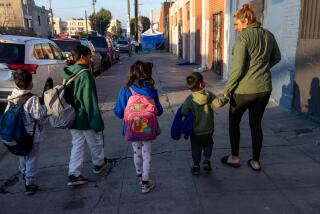Congress Targets AIDS-Plagued Cities : California Could Especially Benefit From the New Federal Involvement
The AIDS problem has cast a pall over our cities and over the gay and minority communities. It is also threatening to strangle local health systems. Congress now seems to understand that the problem won’t go away and must be addressed.
This week the House of Representatives produced a bill--a companion to the one passed by the Senate last month--to provide billions in emergency relief grants to more than a dozen AIDS-plagued metropolitan areas, including Los Angeles, San Diego and San Francisco.
The money is earmarked for preventive and clinical resources that in the past have not received a federal dime. Targeted are AIDS-related clinical services such as testing, counseling and drug therapy, including money for AIDS hospices that could reduce the pressure on besieged municipal hospitals.
A federal commitment in these areas would represent a new level of national investment in the effort to contain this sinister epidemic. The enthusiasm for the House bill, even in the midst of a daunting federal budget crisis, was overwhelming. Only one member of the California delegation--Rep. Duncan L. Hunter (D.-Coronado)--was among the 14 congressmen nationwide voting against the new federal involvement. Even controversial Rep. William E. Dannemeyer (R.-Fullerton) was on board, despite the fact that his House colleagues crushed his pet amendment to compel AIDS reporting by private doctors.
Otherwise the AIDS news has not been as good. A survey cast doubt that safe sex techniques, which are said to characterize the behavior of the white homosexual community, are being adequately practiced by black gay and heterosexual men, thereby raising the odds of transmission in America. And a World Health Organization study predicted at least 6 million AIDS cases worldwide by the year 2000--with astounding rates of epidemic increase in the developing world.
AIDS EPIDEMIC UPDATE
Reported AIDS cases in the United States 1987: 20,821 1988: 32,196 1989: 35,238 1990 (through April): 4,407
Source: Centers for Disease Control
More to Read
Get the L.A. Times Politics newsletter
Deeply reported insights into legislation, politics and policy from Sacramento, Washington and beyond. In your inbox three times per week.
You may occasionally receive promotional content from the Los Angeles Times.










